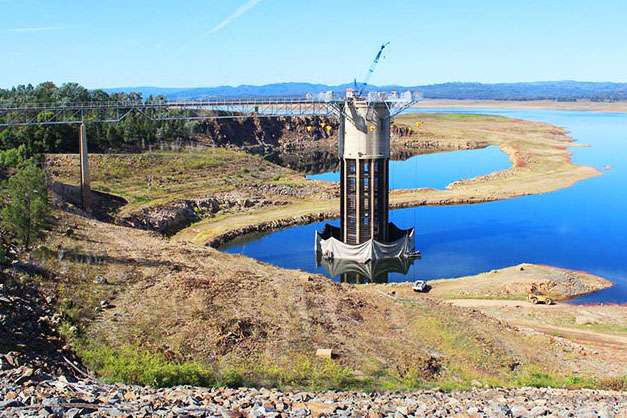A thermal curtain directs warmer surface water to the tower outlet. Credit: Guresh Ahuja, WaterNSW
Just below the sun-warmed surface of a dam, the water temperature can be breath-catchingly cold. So imagine how chilly the water gets when you descend another 20, 30 or even 50 metres to the dam bed.
Thermal stratification, where water layers have different temperatures, is common in large bodies of water, particularly in spring and summer when air temperatures are high.
Water released from outlets near the base of large dams generally comes from the bottom layer and can be as much as 12 degrees colder than the upstream river.
Water for irrigation is typically released from dams in the warmer months between spring and autumn. The rush of unseasonably chilly water is known as cold water pollution.
This pollution by water temperature, not water purity, can wreak havoc with fragile downstream ecosystems. Around the world, the effects are felt in fish breeding, food webs, productivity and the recreational use of rivers below dams.
"River temperatures have really important effects on fish breeding and growth and behaviour," says Simon Mitrovic, a principal research scientist with the NSW Department of Primary Industries (Water) and a senior lecturer in the School of Life Sciences at the University of Technology Sydney (UTS).
Dr Mitrovic is part of the team assessing a $3.4 million, world-first, Australian engineering solution, a Water NSW project that appears to have found a solution to cold-water pollution.
A temperature control structure was installed at the end of last year around an intake tower in Burrendong Dam on the Macquarie River near Wellington, in central-west NSW.
The structure raises and lowers a cylinder of reinforced polypropylene – called a thermal curtain – which diverts the warmer surface water to the dam outlet below.
That means the water released downstream comes from the warmer surface layer rather than the cold depths of the dam's bed.
Dr Mitrovic has been working with environmental biologist Rachel Gray, whose masters thesis examines the impact of the thermal curtain on the thermal rating and water quality of the Macquarie River downstream from the dam.
"We anticipate the river will improve with the use of the thermal control structure, and we're logging the temperature at various sites along the river, comparing the upstream sites – that's the part of the river not affected by the dam – with downstream," Gray says.
She's comparing current data with historic river temperature records to see the impact the releases have had on temperatures in the Macquarie River, and how that changes with distance from the dam, before and after the thermal curtain project.
"So far, we've seen improvements in temperature averaging about 2.5 degrees between the year before and the year after the use of the thermal curtain," she says.
"That might not sound like a lot, but it's actually great news for the ecological health of the river, because organisms living in the river – like many native fish, for example – have a niche temperature range they require for spawning cues, and cues for other life events."
Trent Dorin, who lives in Wellington, has fished the Macquarie River since he was a child. He says the water in his fishing spots, 50 kilometres downstream of the dam, is noticeably warmer.
"The thermal curtain has definitely been a massive improvement for the river system," Dorin says.
He says river levels have been very low, and he's hoping the mitigation of cold water pollution will spark bigger releases from the dam that will further improve fish spawning.
Gray has also taken monthly samples of water quality including nutrient and algae levels in the water.
Releases of water from the bottom of dams generally contain few food sources for downstream fish because phytoplankton does not survive the dark depths.
Gray's thesis is under way so the research is not final but she says that so far, the levels of phytoplankton found downstream from thermal curtain dam releases look more like locations upstream of the dam.
Provided by University of Technology, Sydney





















